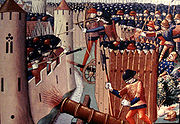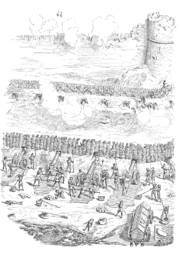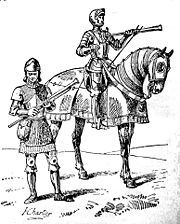
Artillery of France in the Middle Ages
Encyclopedia

Cannon
A cannon is any piece of artillery that uses gunpowder or other usually explosive-based propellents to launch a projectile. Cannon vary in caliber, range, mobility, rate of fire, angle of fire, and firepower; different forms of cannon combine and balance these attributes in varying degrees,...
, in Walter de Milemete
Walter De Milemete
Walter de Milemete was an English scholar who wrote a treatise on Kingship for the young prince Edward, later king Edward III of England called De nobilitatibus, sapientiis, et prudentiis regum in 1326. The Treatise includes images of siege weapons and what is probably the first illustration of a...
's 1326 De Nobilitatibus sapientii et prudentiis regum, and in which start to appear small rudimentary weapons such as the pot-de-fer
Pot-de-fer
The pot-de-fer was a primitive cannon made of iron. It is known as the first metal cannon, and was used by the French in the Hundred Years' War. The name means "iron pot" in French...
or the portable bâton à feu
Bâton à feu
The Bâton à feu, or Baston à feu , is a type of hand cannon developed in the 14th century in Western Europe. This weapon type corresponds to the portable artillery of the second half of 14th century....
. At this early stage, cannon would fire either stone or metal pellets.
14th-century developments

Hundred Years' War
The Hundred Years' War was a series of separate wars waged from 1337 to 1453 by the House of Valois and the House of Plantagenet, also known as the House of Anjou, for the French throne, which had become vacant upon the extinction of the senior Capetian line of French kings...
(1337–1453).
Cannons were soon used at sea, with ships being used as firing platform. Small guns projecting quarrel
Quarrel
A quarrel or bolt is the term for the ammunition used in a crossbow. The name "quarrel" is derived from the French carré, "square", referring to the fact that they typically have square heads. Although their length varies, they are typically shorter than traditional arrows.Bolts and arrows have...
s or lead pellets were used at the 1340 Battle of Sluys
Battle of Sluys
The decisive naval Battle of Sluys , also called Battle of l'Ecluse was fought on 24 June 1340 as one of the opening conflicts of the Hundred Years' War...
, and in the French defense of Tournai
Siege of Tournai (1340)
During the Hundred Years' War, after the naval battle at Sluys on 20 June 1340, in which Edward III of England dealt the French a heavy blow, he went on to besiege Tournai. This city in Flanders was loyal to Philip VI of France....
in August 1340.
Edward III
Edward III of England
Edward III was King of England from 1327 until his death and is noted for his military success. Restoring royal authority after the disastrous reign of his father, Edward II, Edward III went on to transform the Kingdom of England into one of the most formidable military powers in Europe...
used similar weapons at the Battle of Crécy
Battle of Crécy
The Battle of Crécy took place on 26 August 1346 near Crécy in northern France, and was one of the most important battles of the Hundred Years' War...
in 1346, and in the Siege of Calais in 1347. "Ribaldis" were first mentioned in the English Privy Wardrobe accounts during preparations for the Battle of Crécy
Battle of Crécy
The Battle of Crécy took place on 26 August 1346 near Crécy in northern France, and was one of the most important battles of the Hundred Years' War...
between 1345 and 1346.
Cannons evolved considerably towards the end of the century with the collapse of the Treaty of Bretigny
Treaty of Brétigny
The Treaty of Brétigny was a treaty signed on May 9, 1360, between King Edward III of England and King John II of France. In retrospect it is seen as having marked the end of the first phase of the Hundred Years' War —as well as the height of English hegemony on the Continent.It was signed...
and the resumption of the war in 1369. Until 1370, cannons were essentially small weapons of 10 to 20 kg (20 to 40 lbs), made of brass
Brass
Brass is an alloy of copper and zinc; the proportions of zinc and copper can be varied to create a range of brasses with varying properties.In comparison, bronze is principally an alloy of copper and tin...
or copper
Copper
Copper is a chemical element with the symbol Cu and atomic number 29. It is a ductile metal with very high thermal and electrical conductivity. Pure copper is soft and malleable; an exposed surface has a reddish-orange tarnish...
. After that point, larger guns appeared, made of wrought iron
Wrought iron
thumb|The [[Eiffel tower]] is constructed from [[puddle iron]], a form of wrought ironWrought iron is an iron alloy with a very low carbon...
or cast iron
Cast iron
Cast iron is derived from pig iron, and while it usually refers to gray iron, it also identifies a large group of ferrous alloys which solidify with a eutectic. The color of a fractured surface can be used to identify an alloy. White cast iron is named after its white surface when fractured, due...
. During the 1375 siege of Saint-Sauveur-le-Vicomte
Saint-Sauveur-le-Vicomte
Saint-Sauveur-le-Vicomte is a commune in the Manche department in Normandy in north-western France.It is situated in the Cotentin Peninsula near Valognes in the Manche département.Population : 2,242 .-History:...
, French troops successfully breached the walls of the fortress with guns weighing over 1 ton, and firing 50 kg stone balls. The English trailed behind French developments in the area and only had a few such weapons before 1400.
By the end of the century, new firearm types appeared, such as a variety of hand guns, small mortars
Mortar (weapon)
A mortar is an indirect fire weapon that fires explosive projectiles known as bombs at low velocities, short ranges, and high-arcing ballistic trajectories. It is typically muzzle-loading and has a barrel length less than 15 times its caliber....
and ribaudequins. These complemented, but did not replace, heavier artillery.
15th-century developments

Bombard
Bombard may refer to:*The act of carrying out a bombardment*Bombard , a type of late medieval siege weapon.*Bombard , a contemporary double reed instrument used to play traditional Breton music....
s (French bombardes), weighing up to 3 tonnes and firing stone balls of up to 150 kg (300 lbs), which seem to have been more prevalent among the French than among the English until 1420. Such bombards were often made by welding bars of wrought iron together and holding them inside circular bracelet
Bracelet
A bracelet is an article of jewelry which is worn around the wrist. Bracelets can be manufactured from metal, leather, cloth, plastic or other materials and sometimes contain jewels, rocks, wood, and/or shells...
s, a process known as "à tonoille", similar to that involving the manufacture of wine barrels (tonneaux).
Veuglaires (Englic "fowlers") were developed, up to 2 meters (8 feet) long, and weighing from 150 kg to several tonnes, while the crapaudins or crapaudaux were shorter (4 to 8 feet) and lighter than the veuglaires.
The first Western image of a battle with cannon goes back to the Siege of Orleans
Siege of Orléans
The Siege of Orléans marked a turning point in the Hundred Years' War between France and England. This was Joan of Arc's first major military victory and the first major French success to follow the crushing defeat at Agincourt in 1415. The outset of this siege marked the pinnacle of English power...
in 1429, in which both the English and the French side are depicted with firearms. French cannon killed the English commander Thomas Montagu
Thomas Montacute, 4th Earl of Salisbury
Thomas Montacute, 4th Earl of Salisbury, 6th and 3rd Baron Montacute, 5th Baron Monthermer, and Count of Perche, KG was an English nobleman...
in 1428. Joan of Arc
Joan of Arc
Saint Joan of Arc, nicknamed "The Maid of Orléans" , is a national heroine of France and a Roman Catholic saint. A peasant girl born in eastern France who claimed divine guidance, she led the French army to several important victories during the Hundred Years' War, which paved the way for the...
used cannon effectively during the Loire campaign in 1429.

Longbow
A longbow is a type of bow that is tall ; this will allow its user a fairly long draw, at least to the jaw....
s or crossbow
Crossbow
A crossbow is a weapon consisting of a bow mounted on a stock that shoots projectiles, often called bolts or quarrels. The medieval crossbow was called by many names, most of which derived from the word ballista, a torsion engine resembling a crossbow in appearance.Historically, crossbows played a...
s during the Hundred Years War. In contrast, cannon took on a major role in siege warfare, where they came to replace traditional wooden siege engine
Siege engine
A siege engine is a device that is designed to break or circumvent city walls and other fortifications in siege warfare. Some have been operated close to the fortifications, while others have been used to attack from a distance. From antiquity, siege engines were constructed largely of wood and...
s of the types used since antiquity
Ancient history
Ancient history is the study of the written past from the beginning of recorded human history to the Early Middle Ages. The span of recorded history is roughly 5,000 years, with Cuneiform script, the oldest discovered form of coherent writing, from the protoliterate period around the 30th century BC...
.
From the 1430s, the artillery of Charles VII
Charles VII of France
Charles VII , called the Victorious or the Well-Served , was King of France from 1422 to his death, though he was initially opposed by Henry VI of England, whose Regent, the Duke of Bedford, ruled much of France including the capital, Paris...
was managed by the Master Gunner Jean Bureau
Jean Bureau
Jean Bureau was the Master Gunner of the French artillery under Charles VII during the final years of the Hundred Year's War. Bureau was born in Champagne, but later moved to Paris, where he worked for the English government during the occupation. In 1439 Charles VII made Bureau master of...
. Artillery was key to the French successes at Meaux
Meaux
Meaux is a commune in the Seine-et-Marne department in the Île-de-France region in the metropolitan area of Paris, France. It is located east-northeast from the center of Paris. Meaux is a sub-prefecture of the department and the seat of an arondissement...
(1439), Pontoise
Pontoise
Pontoise is a commune in the northwestern suburbs of Paris, France. It is located from the centre of Paris, in the "new town" of Cergy-Pontoise.-Administration:...
(1441), Caen
Caen
Caen is a commune in northwestern France. It is the prefecture of the Calvados department and the capital of the Basse-Normandie region. It is located inland from the English Channel....
and during the Norman Campaign (1449–1450). French artillery was used with great efficiency at the 1453 Battle of Castillon
Battle of Castillon
The Battle of Castillon of 1453 was the last battle fought between the French and the English during the Hundred Years' War. It resulted in a decisive French victory.-Context:...
, in which grouped and entrenched cannons decimated the English army, killing the commander John Talbot
John Talbot, 1st Earl of Shrewsbury
John Talbot, 1st Earl of Shrewsbury and 1st Earl of Waterford KG , known as "Old Talbot" was an important English military commander during the Hundred Years' War, as well as the only Lancastrian Constable of France.-Origins:He was descended from Richard Talbot, a tenant in 1086 of Walter Giffard...
.
Artillery also started to affect military architecture, leading to the development of lower, thicker walls in order to better resist the effect of cannonballs.

